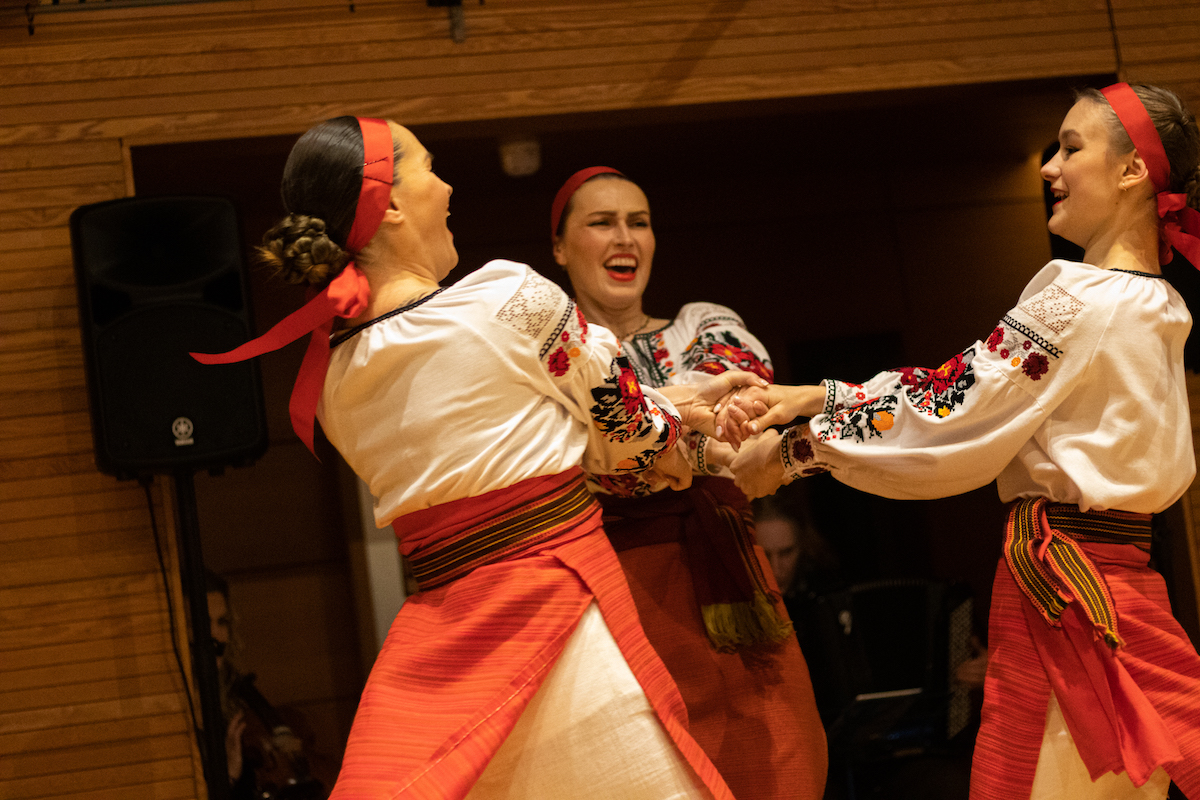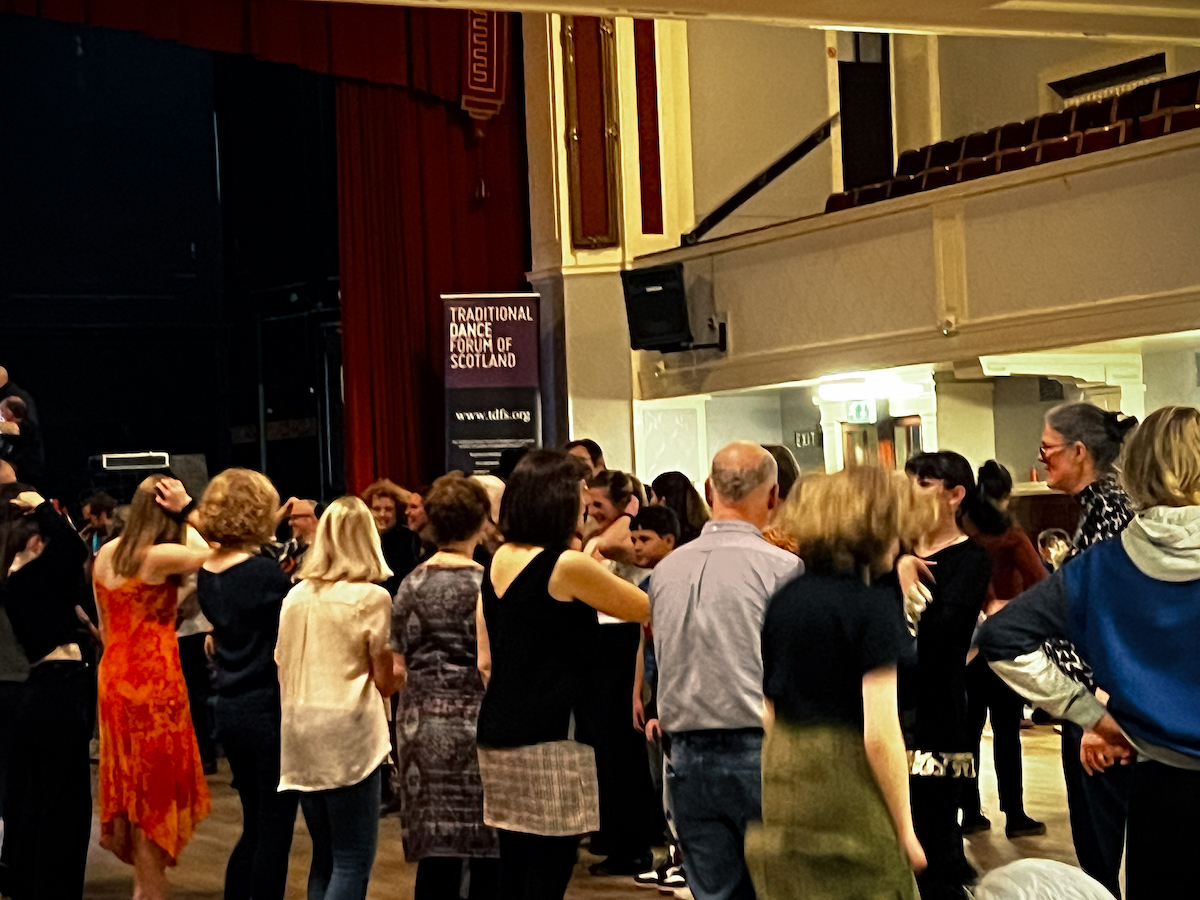In October 2023 we welcomed our new dance artists-in-residence Lingqiao Hong and Yingzhou Xie. Their residency is part of our ongoing partnership with Moray House School of Education and Sport at the University of Edinburgh which enables graduate students in Dance Education and Science to undertake their formal placement at Traditional Dance Forum of Scotland. By December 2023, Lingqiao and Yingzhou, affectionately known as Ling and Jayden, had made a substantial curatorial contribution to our new production Elegies and explored three ceilidh dances at three different locations across Edinburgh. Ceilidh-wise, their mission was to critically reflect on their experience and share their thoughts in a joint review specifically commissioned for our own online platform for reviews of traditional dance events across Scotland. What does Scottish Ceilidh share with Chinese Hanfu and Mongolian dance cultures? Read the review to find out.
*
One, Two, Three – Ceilidh On
Review by Lingqiao Hong and Yingzhou Xie
*
If you were to arrive in Edinburgh in autumn 2023 you wouldn’t have to try hard to find somewhere to go ceilidh dancing. The city appeared to be experiencing a ceilidh boom following the Covid-inflicted hiatus of no social dancing across Edinburgh. We were honoured to participate in three different ceilidh dance nights, each at a distinct location – the British Legion Hall, Portobello Town Hall and the Scottish Storytelling Centre.
Our initial impressions? Enthusiasm and vitality. Ceilidh dance is not just a social activity, but an integral part of Scottish culture. It reflects Scotland’s history, traditions and community spirit, deepening connections through physical and eye contact, and sharing a cultural heritage together. Under the soft skies of Scotland, the lively scene of ceilidh dance seems to connect everyone’s hearts closely. This is not just a dance, but a fusion of hearts, a warm embrace of the community. As traditional instruments play together, people’s footsteps lightly follow the rhythm, dancing to the melody filled with joy.
Whether it is the laughter of children, the passion of the youth, or the steadiness of the elders, every dance step crosses the boundaries of age, connecting different souls. Each exchange of glances in the dance is a silent communication, every interaction an extension of friendship. Here, we are not just dancing, but conversing with history, shaking hands with culture, and embracing the world.
The true charm of the Scottish ceilidh dance lies in its inclusivity. It welcomes people from different countries, of different skin colours, without any preset prejudice, only pure acceptance and joy. In such an atmosphere, warmth and hospitality are not only Scottish traditions but are also created by every dancer. The people dancing do not differentiate; their smiles and hugs tell a story of unity, joy, and vitality.
Music is the soul of ceilidh dance. The loud singing of the accordion and the vigorous melody of the violin are indispensable to this dance. Every fluctuation of the tune resonates with our heartbeat, driving the change in our steps. The pace and the ups and downs of the tune cleverly match the rhythm of the dance, leading participants into a world of dance filled with emotion and stories. Especially in dances like Strip the Willow, the acceleration of the music intensifies the enthusiasm of the dance, showcasing the uniqueness of ceilidh as a social dance.
In ceilidh dance, the attire is not just for decoration, but also a symbol of identity and culture. The men’s kilts and women’s pleated skirts adorned with Scottish tartan patterns exude historical charm with every twirl. The intricate details, such as the delicate buckles on the belts and the elaborate embroidery on the shawls, narrate the profound cultural heritage of Scotland. At the same time, the style of these costumes echoes the elegance of Chinese Hanfu robes and the splendid attire of the Mongolian people, showcasing the respect and preservation of traditional clothing across different cultures. These garments are not only symbols of identity but also witnesses to cultural identity and history.
As for the movements, the actions in ceilidh dance are a display of social interaction and skill. From the simplicity of hand-in-hand to the complexity of group choreography, every step and turn requires tacit understanding and coordination among the dancers. It’s not only a test of the dancers’ memory and response speed, but also of their spirit of teamwork. The movements in the dance foster interdependence and cooperation, thereby deepening social connections.
The ceilidh dance evening soon drew to a close, and people clasped arms, singing Auld Lang Syne together. They reminisced about the past, celebrated the present friendships, and looked forward to the future. It was an emotional release, a celebration of shared experiences, and a tribute to the passage of time. We felt not just the end of a tradition, but also the continuation of a culture.
*
Review and images by Lingqiao Hong and Yingzhou Xie. Traditional Dance Forum of Scotland residency mentorship and editorial support by Iliyana Nedkova. Residency coordianted by Heather Rikic, Moray House School of Education and Sport, the University of Edinburgh.








